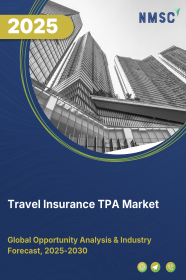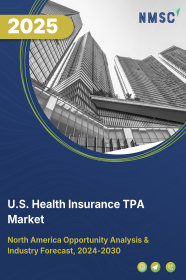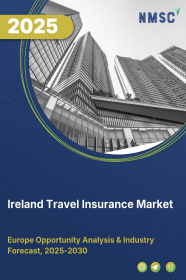
Travel Insurance Third Party Administrator (TPA) Market by Type of Coverage (Medical Coverage, and Others), by Services (Claims Management, Risk Control Management, Underwriting Services, and Others), by Deployment (In-House TPAs, Outsourced TPAs), by Sales Channel (Direct Selling, & Others), by Enterprise Size (Small and Medium Size Enterprise (SME), Large Enterprise), and by End Users (Insurance Companies, and Others) – Global Opportunity Analysis and Industry Forecast 2025-2030
US Tariff Impact on Travel Insurance TPA Market
Trump Tariffs Are Reshaping Global Business
Travel Insurance Third Party Administrator (TPA) Market Overview
The global Travel Insurance Third Party Administrator Market size was valued at USD 1.82 billion in 2024 and is predicted to reach USD 2.17 billion by the end of 2025. The industry is predicted to reach USD 5.29 billion by 2030 with a CAGR of 19.5% from 2025-2030.
The travel insurance TPA market is driven by the growth of global travel, increasing demand for insurance, and the need for TPAs to manage claims efficiently. Rising customer expectations for quick, seamless service and the complexity of travel insurance policies further fuel market growth. However, data security concerns pose challenges, requiring robust security measures. Despite this, opportunities exist in adopting AI, automation, and data analytics to streamline operations and enhance customer satisfaction, supporting TPAs' growth in the expanding travel insurance market.
The Growth of Global Travel and Tourism Fuels the Travel Insurance TPA Market
The most fundamental driver fueling the travel insurance TPA sector is the consistent growth of global travel and tourism. As more people travel for leisure, business, and education, the demand for travel insurance naturally surges, subsequently increasing the need for TPAs to manage the associated claims and administrative processes. Whether it's a family vacation abroad, a business trip across continents, or a student exchange program, the sheer volume of travelers worldwide contributes significantly to the market size and growth potential of travel insurance and, by extension, the TPAs that support it. The rise in disposable incomes and the increasing ease of travel arrangements further amplify this trend, making it a cornerstone of the market expansion.
The Demand for Better Customer Experience Boosts the Travel Insurance TPA Industry Growth
Tech-savvy travelers expect fast, smooth, and reliable service, which is a major driver for the travel insurance TPA market. Travelers want quick and easy claims processing, and TPAs play a key role in making that possible. By using technology, TPAs offer round-the-clock support, clear communication, and efficient service. A strong customer experience now plays an important role in the selection of insurance providers and the TPAs they partner with. As more people purchase travel insurance, TPAs that provide excellent service through innovation and efficiency will be in greater demand.
The Increasing Need for Regulatory and Policy Expertise Propels the Market
The increasing complexity of travel insurance policies and the regulatory landscape surrounding them is another key driver for the growth of the TPA market. Travel insurance products now offer a wide array of coverage options, from medical emergencies and trip cancellations to baggage loss and adventure sports. Navigating these intricate policies and ensuring compliance with different regional regulations be challenging for both insurers and policyholders. TPAs possess the specialized knowledge and infrastructure to manage this complexity effectively, acting as intermediaries to streamline processes, interpret policy terms, and facilitate smooth claim settlements. This expertise makes them indispensable partners for insurance companies looking to offer comprehensive and compliant travel insurance solutions in an evolving global environment.
Data Security and Privacy Concerns Restrain the Travel Insurance TPA Market
One significant restraint or challenge in the travel insurance TPA market is the growing concern around data security and privacy. As TPAs handle sensitive personal and medical information of travelers, ensuring the security and confidentiality of this data is paramount. The increasing frequency of cyber threats and the stringent data protection regulations worldwide necessitate significant investments in robust security measures and compliance frameworks. Any breach of data lead to severe reputational damage and legal repercussions, hindering the growth and trust in TPAs. Therefore, addressing these concerns through advanced security technologies, transparent data handling practices, and adherence to global regulations is crucial for the sustained success of the industry.
Technological Advancements Creates Growth Opportunities in the TPA Market
A significant opportunity for players in the travel insurance TPA market lies in expanding their service offerings through the integration of advanced technologies. Artificial intelligence (AI), automation, and data analytics revolutionize various aspects of TPA operations, from fraud detection and claims processing to personalized customer support and risk assessment.
For instance, in April 2025, Allianz Partners launched an AI-driven claims processing platform that integrates advanced data analytics and automation to streamline fraud detection and enhance customer support, significantly reducing processing times and improving policy personalization. This innovation reflects the broader trend of leveraging technology to boost efficiency and customer satisfaction. By embracing such advancements, TPAs enhance operational effectiveness, improve customer engagement, and deliver more comprehensive and innovative services, thereby solidifying their position in the growing travel insurance industry.
Market Segmentation and Scope of Study
The travel insurance TPA market report is divided on the basis of type of coverage, services, deployment, sales channel, enterprise size, and end users. On the basis of type of coverage, the market is divided into medical coverage, trip cancellation, baggage coverage, travel delay, accidental death and dismemberment, and others. On the basis of services, the market is divided into claims management, risk control management, underwriting services, policy administration, and others. On the basis of deployment, the market is divided into in-house TPAs and outsourced TPAs. On the basis of sales channel, the market is divided into direct selling, agents, and brokers. On the basis of enterprise size, the market is divided into small and medium-sized enterprises (SMEs) and large enterprises. On the basis of end users, the market is divided into insurance companies, the corporate sector, travel companies, and others. Regional breakdown and analysis of each of the aforesaid segments includes regions comprising of Asia-Pacific, North America, Europe, and RoW.
Geographical Analysis
North America represents a significant portion of the overall travel insurance TPA market, TPAs is highly developed, reflecting the region’s substantial outbound and inbound travel activity. The United States, in particular, is a hub for global TPA operations, with major players like CVS Health Caremark contributing to the maturity of the sector. The demand for TPA services is driven by travelers’ need for real-time support in navigating complex medical systems, reimbursement procedures, and cross-border coordination. The region’s regulatory framework and emphasis on data security and customer service further reinforce the demand for technologically advanced and compliant TPA solutions. As a result, North America continues to be a benchmark for operational excellence in the travel insurance TPA sector.
Europe presents a dynamic and diversified TPA landscape, shaped by the high volume of intra-European and international travel. The region's travel insurance sector is supported by a wide array of providers offering niche and generalist policies, which in turn requires TPAs to deliver tailored administrative and claims services. European TPAs often operate across multiple languages and legal frameworks, necessitating a strong focus on cross-border efficiency, multilingual service delivery, and regulatory knowledge. The strong presence of travel hubs, such as London, Paris, and Frankfurt, reinforces the need for TPAs that can manage large volumes of claims with accuracy and speed.
In the Asia-Pacific region, the travel insurance third party administrator (TPA) market is experiencing rapid growth, aligned with the region’s expanding travel and tourism sector. Countries such as India, China, Japan, and Australia are witnessing increased demand for travel insurance, driven by rising income levels, growing awareness of travel risks, and a surge in outbound tourism. This has led to a parallel rise in the demand for TPAs that can support high volumes of claims, particularly for medical emergencies abroad. India, in particular, is emerging as both a growing market and a service hub for TPAs, offering cost-effective, tech-enabled claims processing and customer support services. The region is also experiencing an uptick in partnerships between insurers and TPAs to streamline operations and deliver integrated digital solutions.
The Rest of the World, encompassing Latin America, the Middle East, and Africa, showcases a more varied but increasingly promising landscape for travel insurance TPAs. While the TPA infrastructure in some of these regions is still developing, rising travel activity and increasing adoption of travel insurance are creating a fertile ground for growth. In Latin America and the Middle East, the need for multilingual, regionally adaptive TPA services is evident as international travel increases. In Africa, improvements in insurance literacy and digital connectivity are paving the way for TPAs to offer remote claims handling and tele-assistance services, especially in areas with limited physical healthcare infrastructure.
Strategic Moves Adopted by Key Players
Key players in the global travel insurance TPA industry are increasingly adopting digital technologies and AI to enhance their service offerings and streamline operations. For instance, some are leveraging AI-powered chatbots to provide instant customer support and improve the overall customer journey. This focus on technology aligns with the market trend of increasing demand for seamless and efficient service, which is a significant driver for the industry. Personalization is another key strategy, with TPAs looking to support the development of more flexible and tailored travel insurance products to meet diverse traveler needs. However, these advancements come with challenges, notably data security and privacy concerns, as handling sensitive traveler information necessitates robust security measures.
Another challenge lies in adapting to evolving travel patterns and risks, as highlighted by the need to respond to events like pandemics and geopolitical shifts. Despite these restraints, significant opportunities exist. TPAs are exploring expanding their service portfolios through technological integrations, offering more comprehensive assistance services that go beyond traditional claims processing. Furthermore, forging strategic partnerships with insurers and travel providers presents another avenue for growth, allowing TPAs to embed their services within broader travel ecosystems. While specific developments of each individual player are not detailed across the sources, the mention of CVS Health Caremark as a leader in the broader Insurance TPA market suggests that established players are likely investing heavily in technology and scale to maintain their market share and capitalize on the growth potential of the travel insurance sector.
Key Benefits
-
The report provides quantitative analysis and estimations of the travel insurance TPA market from 2025 to 2030, that assists in identifying the prevailing market opportunities.
-
The study comprises a deep-dive analysis of the travel insurance TPA market including the current and future trends to depict prevalent investment pockets in the market.
-
Information related to key drivers, restraints, and opportunities and their impact on the travel insurance TPA market is provided in the report.
-
Competitive analysis of the players, along with their market share is provided in the report.
-
SWOT analysis and Porters Five Forces model is elaborated in the study.
-
Value chain analysis in the market study provides a clear picture of roles of stakeholders.
Travel Insurance TPA Market Key Segments
By Type of Coverage
-
Medical Coverage
-
Trip Cancellation
-
Baggage Coverage
-
Travel Delay
-
Accidental Death and Dismemberment
-
Others
By Services
-
Claims Management
-
Risk Control Management
-
Underwriting Services
-
Policy Administration
-
Others
By Deployment
-
In-House TPAs
-
Outsourced TPAs
By Sales Channel
-
Direct Selling
-
Agents
-
Brokers
By Enterprise Size
-
Small and Medium-Sized Enterprises (SMEs)
-
Large Enterprises
By End Users
-
Insurance Companies
-
Corporate Sector
-
Travel Companies
-
Others
By Region
-
North America
-
The U.S.
-
Canada
-
Mexico
-
-
Europe
-
The UK
-
Germany
-
France
-
Italy
-
Spain
-
Denmark
-
Netherlands
-
Finland
-
Sweden
-
Norway
-
Russia
-
Rest of Europe
-
-
Asia-Pacific
-
China
-
Japan
-
India
-
South Korea
-
Australia
-
Indonesia
-
Singapore
-
Taiwan
-
Thailand
-
Rest of Asia-Pacific
-
-
Rest of the World
-
Latin America
-
Middle East
-
Africa
-
Key Players
-
Sedgwick Claims Management Services Ltd (Sedgwick)
-
Paramount Health Group
-
Global Voyager Assistance (GVA)
-
McLarens
-
Crawford & Company
-
World Travel Protection Canada Inc.
-
Healix
-
PLEXIS Healthcare Systems
-
The Collinson Group Limited
-
Charles Taylor
-
Chubb
-
Helmsman Management Services LLC
-
Berkshire Hathaway Specialty Insurance Company
-
Worldwide Insurance Services, LLC
-
HTH Worldwide
REPORT SCOPE AND SEGMENTATION:
|
Parameters |
Details |
|
Market Size in 2024 |
USD 1.82 Billion |
|
Revenue Forecast in 2030 |
USD 5.29 Billion |
|
Growth Rate |
CAGR of 19.5% from 2025 to 2030 |
|
Analysis Period |
2024–2030 |
|
Base Year Considered |
2024 |
|
Forecast Period |
2025–2030 |
|
Market Size Estimation |
Billion (USD) |
|
Growth Factors |
|
|
Countries Covered |
28 |
|
Companies Profiled |
15 |
|
Market Share |
Available for 10 companies |
|
Customization Scope |
Free customization (equivalent to up to 80 working hours of analysts) after purchase. Addition or alteration to country, regional, and segment scope. |
|
Pricing and Purchase Options |
Avail customized purchase options to meet your exact research needs. |

















 Speak to Our Analyst
Speak to Our Analyst





















